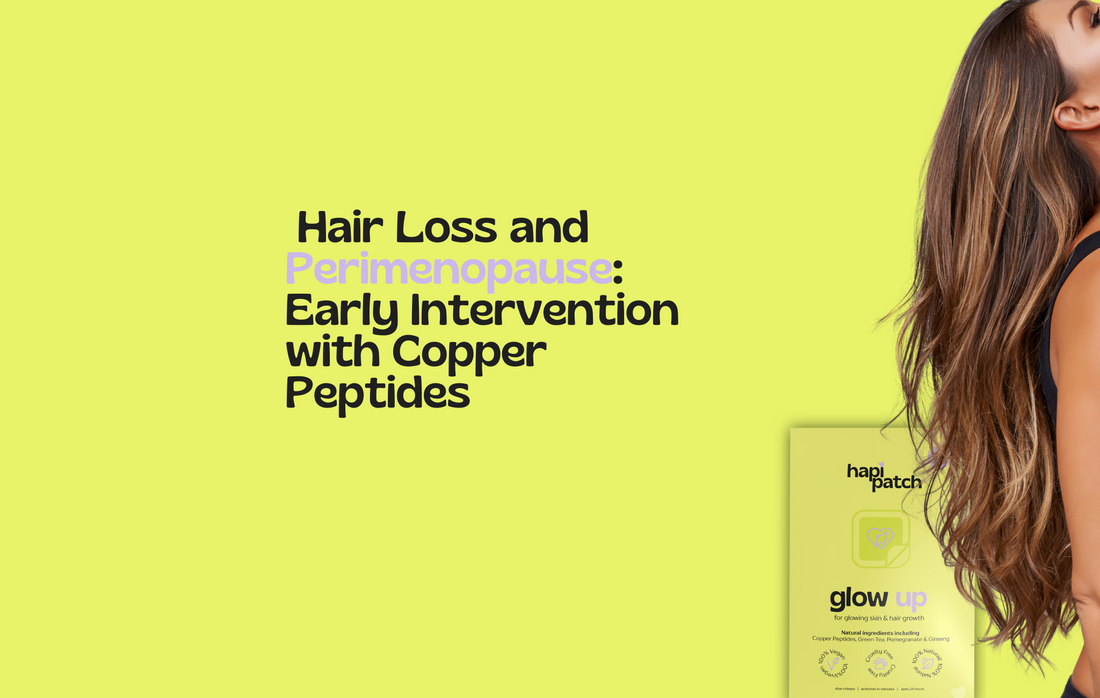Hair loss is often associated with menopause, but for many women, it begins during perimenopause, the transitional phase before menopause. During this time, hormonal changes start to impact the hair growth cycle, leading to thinning hair, increased shedding, and slower regrowth. In this blog, we'll explore the connection between perimenopause and hair loss, why early intervention is critical, and how copper peptides, specifically Copper Peptide Patches from hapi patch, provide an effective solution for preventing further hair thinning and promoting regrowth.
What happens during perimenopause?
Perimenopause typically starts in a woman's 40s, though it can begin earlier or later, and lasts until menopause officially begins. During perimenopause, the body undergoes significant hormonal fluctuations, which can trigger a range of symptoms, including changes in hair health. Here's how these hormonal shifts affect the hair growth cycle:
- Declining oestrogen: Oestrogen helps keep hair follicles in the anagen (growth) phase longer. As oestrogen levels start to fluctuate and decline during perimenopause, hair follicles spend less time growing and more time resting, leading to thinning and shedding.
- Increased androgen dominance: As oestrogen decreases, androgens such as testosterone and DHT (dihydrotestosterone) become more dominant. DHT is known to shrink hair follicles, causing them to produce thinner, weaker hair strands or stop producing hair altogether.
- Nutrient deficiencies: During perimenopause, women are more likely to experience nutrient deficiencies, particularly in iron and biotin, both of which are crucial for hair health. These deficiencies can further exacerbate hair loss and slow regrowth.
Early intervention is key: Why addressing hair loss during perimenopause is critical
Hair loss during perimenopause can start gradually, with thinning at the crown or temples. However, without early intervention, this hair loss can become more severe during menopause. Here’s why taking action early is essential:
- Preventing further follicle shrinkage: Once hair follicles shrink due to DHT, it becomes harder for them to produce healthy hair strands. Early treatment can help prevent or reverse this shrinkage before it becomes irreversible.
- Stimulating dormant follicles: During perimenopause, some hair follicles enter a dormant phase. Early intervention can help stimulate these follicles back into the growth phase, promoting regrowth and preventing thinning.
- Maintaining scalp health: A healthy scalp is essential for hair growth. Treating hair loss early can help maintain scalp health, preventing dryness, inflammation, and other conditions that could further hinder hair growth.
Why shampoos and topical treatments aren't enough
Many women try to address early hair loss with shampoos or topical treatments, but these methods fall short because they don’t target the root causes of hair thinning during perimenopause:
- Surface-level treatment: Shampoos only clean the scalp and don’t penetrate deep enough to reach the hair follicles, where hair growth occurs.
- Lack of hormonal impact: Shampoos and topical treatments can’t address the hormonal imbalances that lead to hair thinning during perimenopause, meaning they don’t tackle the root cause of the issue.
- Short application time: Hair growth requires consistent stimulation, but shampoos are rinsed off quickly, limiting their effectiveness.
How copper peptides help prevent and reverse perimenopausal hair loss
Copper peptides, especially GHK-Cu, are scientifically proven to stimulate hair follicles and promote regrowth. Here's how they work:
- Blocking DHT: GHK-Cu helps reduce the effects of DHT on hair follicles, preventing them from shrinking and promoting healthier hair growth.
- Extending the growth phase: Copper peptides stimulate hair follicles to remain in the anagen (growth) phase longer, helping prevent premature shedding and promoting thicker, stronger hair strands.
- Boosting collagen production: GHK-Cu stimulates the production of collagen, which strengthens the scalp and hair follicles, providing a healthier environment for hair to grow.
Why transdermal delivery works best for perimenopausal hair loss
The most effective way to treat perimenopausal hair loss is through a solution that reaches the bloodstream and hair follicles directly. Transdermal patches like Glow Up Copper Peptide Patches offer the best solution by delivering copper peptides efficiently through the skin to target hair follicles.
- Deep absorption: Glow Up Copper Peptide Patches deliver copper peptides directly into the skin, penetrating deeply to reach hair follicles and stimulate growth.
- Sustained release: The patches provide a controlled, steady release of copper peptides over several hours, ensuring continuous stimulation of the hair follicles for optimal regrowth.
- Efficient delivery: Unlike shampoos or oral supplements, Glow Up patches bypass the digestive system, ensuring that the active ingredients are delivered directly to the bloodstream for maximum effectiveness.
Why Glow Up Copper Peptide Patches are ideal for perimenopausal hair loss
Glow Up Copper Peptide Patches from hapi patch offer a science-backed, reliable solution for addressing early hair thinning during perimenopause. Here’s why:
- Targeted treatment: Glow Up patches allow for precise application, delivering copper peptides directly to areas of thinning hair to stimulate follicles and promote regrowth.
- 4-layered matrix design: The patches ensure superior absorption and consistent delivery of GHK-Cu, helping to reverse thinning and improve scalp health.
- Non-hormonal solution: Copper peptides provide a natural, non-hormonal way to address hair thinning during perimenopause without the side effects of hormone-based treatments.
Real results: Before and after success stories
Women who experienced early hair thinning during perimenopause have seen remarkable results after using Glow Up Copper Peptide Patches. Here are some of their success stories:
- Fiona, age 45: "I noticed my hair thinning around my temples when I hit my mid-40s. After trying Glow Up patches, I’m seeing real regrowth. My hair looks fuller, and I’ve stopped shedding as much."
- Joanne, age 48: "The hair loss started gradually, but it quickly became noticeable. Glow Up patches were a game-changer. My hair is growing back, and the thinning spots are filling in."
FAQs About Copper Peptides for Perimenopausal Hair Loss
Can perimenopause cause hair loss?
Yes, hormonal fluctuations during perimenopause can trigger hair thinning and increased shedding, especially as oestrogen levels decline.
How do copper peptides help with hair loss during perimenopause?
Copper peptides help block DHT, stimulate hair follicles, and boost collagen production, all of which are essential for preventing hair loss and promoting regrowth.
How long does it take to see results with copper peptides?
Many women notice visible improvements in hair thickness and reduced shedding within 2-3 months of consistent use.
Are copper peptides safe for long-term use during perimenopause?
Yes, copper peptides are non-toxic and safe for long-term use to treat hair thinning caused by hormonal changes during perimenopause.
How do Glow Up Copper Peptide Patches work for perimenopausal hair loss?
Glow Up patches deliver copper peptides directly to the scalp, stimulating hair follicles and supporting scalp health for long-lasting hair regrowth.

